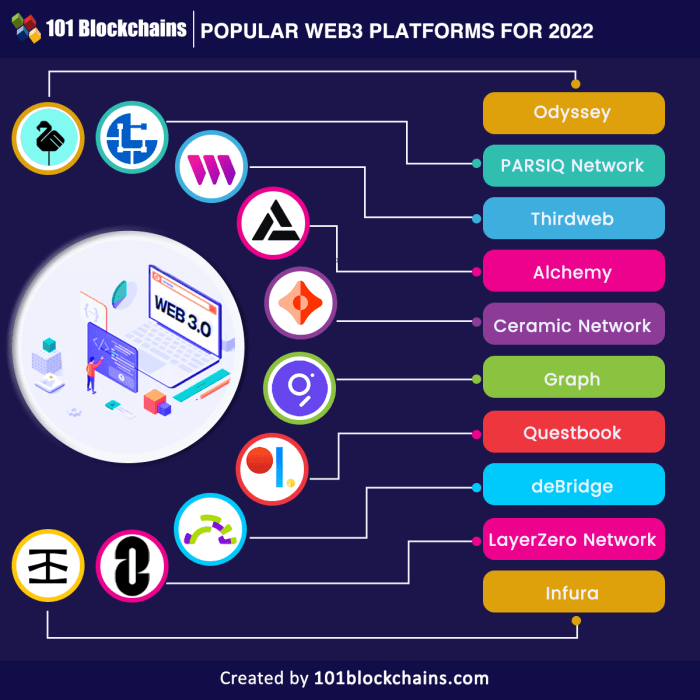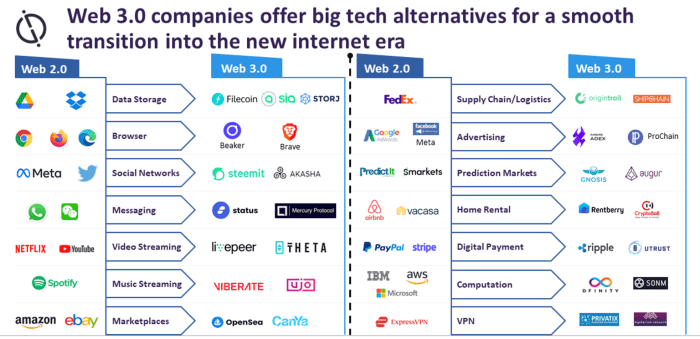Web3 applications are all the rage, bringing a new wave of innovation and possibilities to the digital landscape. From blockchain to smart contracts, get ready to dive into a world where decentralization reigns supreme.
Get ready to explore the ins and outs of Web3 applications, from their unique features to the challenges and opportunities they present.
Definition of Web3 Applications

Web3 applications, also known as decentralized applications (dApps), are a new generation of applications that run on decentralized networks, such as blockchain technology. Unlike traditional web applications that rely on centralized servers, Web3 applications operate on a peer-to-peer network, making them more secure, transparent, and censorship-resistant.
Examples of Popular Web3 Applications
- Uniswap: A decentralized exchange platform for trading cryptocurrencies without intermediaries.
- Brave Browser: A privacy-focused web browser that rewards users with cryptocurrency for viewing ads.
- Decentraland: A virtual reality platform where users can buy, sell, and build on virtual land using blockchain technology.
Key Features of Web3 Applications
- Decentralization: Web3 applications operate on decentralized networks, eliminating the need for intermediaries and increasing security.
- Transparency: Transactions on Web3 applications are recorded on a public blockchain, providing a transparent and immutable record of activity.
- Censorship resistance: Web3 applications are resistant to censorship, as they are not controlled by any single entity or government.
- Smart contracts: Web3 applications can leverage smart contracts to automate and enforce agreements without the need for intermediaries.
Technologies Powering Web3
Web3 applications rely on a combination of cutting-edge technologies to operate efficiently and securely.
Blockchain Technology
Blockchain serves as the underlying foundation for Web3 applications, providing a decentralized and immutable ledger for transactions and data storage.
Decentralized Storage
Decentralized storage solutions, such as IPFS (InterPlanetary File System) and Swarm, enable Web3 applications to store data across a network of nodes, ensuring data integrity and availability.
Smart Contracts
Smart contracts, powered by blockchain technology, allow for self-executing contracts with predefined conditions, enabling automation and trustless interactions within Web3 applications.
Comparison with Traditional Web Applications
- Web3 applications require a decentralized infrastructure, unlike traditional web applications that rely on centralized servers.
- Blockchain technology ensures data transparency and security in Web3 applications, while traditional web applications may face data breaches and centralization risks.
- Smart contracts in Web3 applications facilitate automated transactions without the need for intermediaries, reducing costs and increasing efficiency compared to traditional web applications.
Use Cases of Web3 Applications
Web3 applications are revolutionizing various industries and sectors by leveraging blockchain technology to enhance security, privacy, and decentralization.
Finance and Banking
- Decentralized finance (DeFi) platforms enable users to access financial services without intermediaries, offering lower fees and increased accessibility.
- Blockchain-based digital currencies provide secure and transparent transactions, reducing the risk of fraud and enhancing financial inclusion.
- Smart contracts automate processes like lending, borrowing, and trading, improving efficiency and reducing human error.
Healthcare
- Secure storage and sharing of medical records on blockchain networks ensure patient data privacy and integrity, while enabling seamless access for healthcare providers.
- Tokenization of healthcare assets allows for transparent tracking of pharmaceuticals, medical devices, and research data, reducing counterfeit products and ensuring authenticity.
- Decentralized clinical trials powered by smart contracts enhance transparency, data security, and patient consent management.
Retail and Supply Chain
- Blockchain technology enables tracking and tracing of products throughout the supply chain, ensuring authenticity, quality control, and ethical sourcing.
- NFTs (Non-Fungible Tokens) are used to verify the authenticity of luxury goods, artwork, and collectibles, reducing the risk of counterfeit products in the retail market.
- Decentralized marketplaces powered by smart contracts facilitate peer-to-peer transactions, eliminating the need for intermediaries and reducing costs for both buyers and sellers.
Challenges and Opportunities

In the realm of Web3 applications, developers face a unique set of challenges and opportunities that shape the landscape of innovation and growth within the ecosystem.
Challenges Faced by Developers
Developers encounter various challenges when building Web3 applications, including:
- Complexity of Decentralized Systems: Working with decentralized technologies such as blockchain can be intricate and require specialized knowledge.
- Data Management: Handling large amounts of data securely while maintaining privacy is a significant challenge.
- Interoperability Issues: Ensuring seamless communication and interaction between different decentralized applications can be complex.
- Scalability Concerns: Scaling decentralized applications to accommodate a growing user base remains a significant challenge.
Scalability Issues and Potential Solutions
Scalability is a critical concern for Web3 applications due to the limitations of blockchain technology. Some potential solutions include:
- Layer 2 Solutions: Implementing layer 2 scaling solutions such as sidechains or state channels can help improve transaction throughput.
- Sharding: Utilizing sharding techniques to partition data and transactions can enhance scalability by distributing the workload.
- Off-chain Processing: Moving certain operations off-chain can alleviate the burden on the main blockchain network.
Opportunities for Innovation and Growth
Within the Web3 ecosystem, there are vast opportunities for innovation and growth, including:
- Decentralized Finance (DeFi): DeFi applications continue to revolutionize traditional financial services by providing decentralized and inclusive financial solutions.
- Non-Fungible Tokens (NFTs): The rise of NFTs has opened up new possibilities for digital ownership and asset tokenization across various industries.
- Decentralized Autonomous Organizations (DAOs): DAOs enable decentralized decision-making and governance structures, fostering community-driven initiatives.